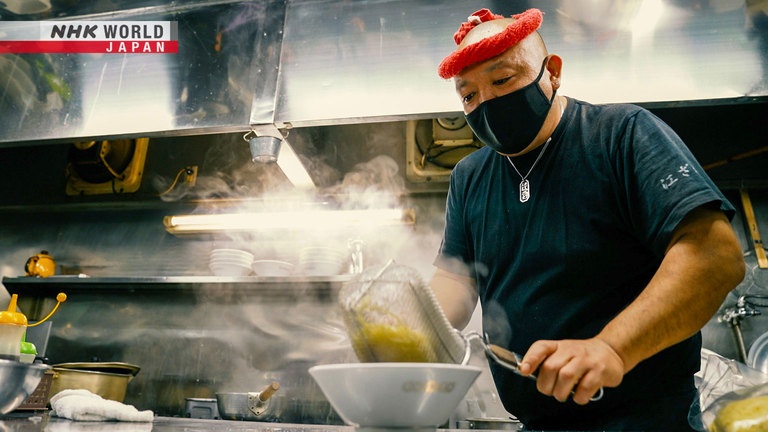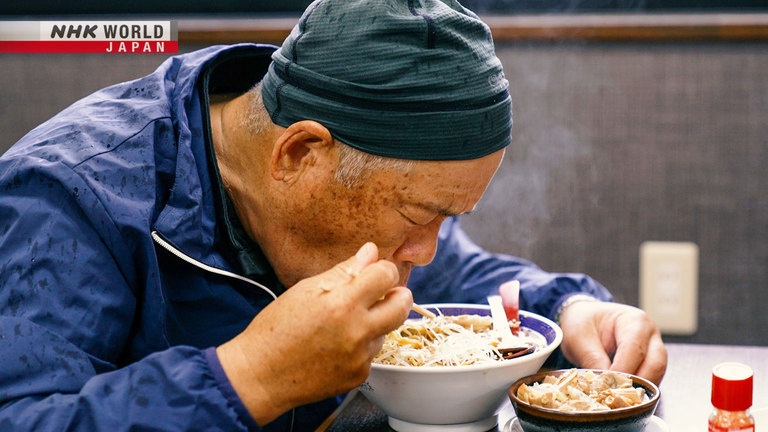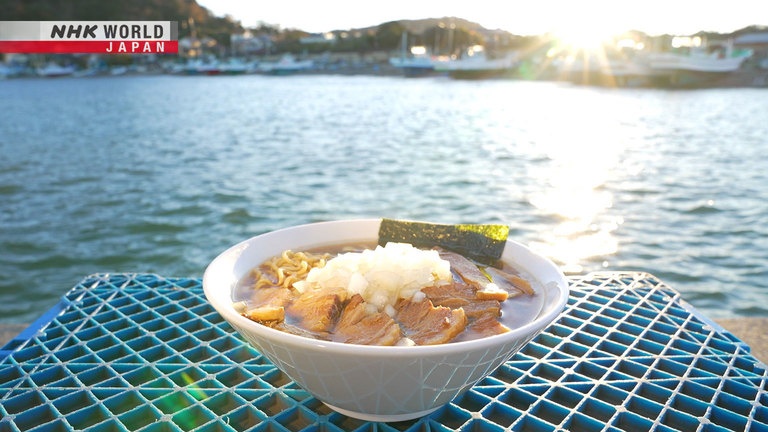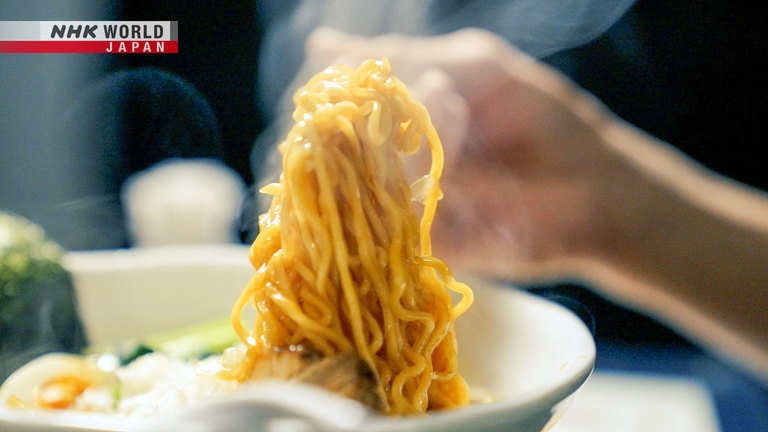CHIBA
Explore a surprising take on ramen loved by a fishing town. Let it warm you up when it's cold!




Transcript
Ramen Japan! This time in Chiba, known for its fabulous fish!
We'll look at two varieties, both from fishing towns.
Get 'em while they're hot!
Welcome to Japan, the land of ramen!
Surrounded by water with the Pacific Ocean to the east and Tokyo Bay to the west,
Chiba is a peninsula.
Our first bowl of ramen comes from Katsuura on the Pacific side.
Long home to a thriving fishing industry, this port town is home to some 20,000 people.
Early morning... A skipjack tuna fishing boat enters the harbor.
They use no nets, only fishing rods.
Katsuura is the number one fishing port for this type of fish in the Kanto region.
Naturally the eateries around the harbor are famous for their skipjack tuna sashimi.
But by far the most popular item on the menu is actually...
You guessed it! Ramen!
Outside many of the restaurants in the area you'll find flags advertising ramen.
Places offering grilled meat. Seafood places too.
At classic eateries like this.
And even...
This Italian dining bar with a view of the Pacific.
Alongside pizza and pasta, here too you'll find ramen on the menu.
It's made by Katsuura-born-and-raised Italian chef, Mizuno Tsukasa.
My first memory of it is from childhood.
I wondered why it was so spicy.
The ramen Katsuura loves best, "tantanmen" is very spicy indeed.
In Katsuura, ramen is "tantanmen."
So, how is Katsuura tantanmen made?
The standard version is a soy sauce base, blended with dashi soup stock.
So far, a classic shoyu ramen.
But the ingredients that come next completely change the flavor.
For Katsuura "tantanmen" we always add
onions, ground meat, and chili oil for heat.
Using vegetable oil and red chili powder, this shop makes their own chili oil from scratch.
Along with the ground meat and onions, plenty of spicy chili oil is added.
Cooked slow; the onion's sweetness,
the chili oil's heat and pork's umami.
Those three are key.
In the world of ramen it's an outlier.
You'll only find this taste in Katsuura.
- Good even if you don't do spicy food.
- Yeah, the onions add sweetness.
At the end of a shift we all go out for
Katsuura "tantanmen." Great with a drink.
The father of Katsuura tantanmen is this man, Ezawa Tsutomu.
The shop he ran is still in business today.
Come in!
The inheritor of the taste he created, his grandson, Masaki.
As well as his son, Fumihiko.
According to Dad, it came from a dish
he tried in Manchuria during the war.
The spice made a lasting impression.
The elder Ezawa opened his Katsuura eatery in 1950.
And around four years later, he recreated the Chinese tantanmen recipe he remembered.
In the beginning it was just spicy.
To make it a bit milder he added onions.
That's how our "tantanmen" was created.
It was the birth of Katsuura tantanmen.
Everyone on the fishing boats eats it
to warm up before going home.
Once Ezawa's tantanmen became popular with the fishermen, it quickly spread all over Katsuura.
These men all remember that original taste.
You have to fatten up or you get cold,
so you eat lots of fatty foods.
I always break a sweat eating here.
There's a strong soy sauce flavor,
but there's heat too.
Being sweet and spicy makes it great.
We heat it up right before serving,
so customers enjoy it piping hot.
Ezawa's son Fumihiko began working in the shop at just 17.
But in 1987, he had no choice but to close the shop...
Then, two years later, his father Tsutomu passed away.
That tantanmen taste had disappeared.
12 years passed...
Despite the gap, I had to try again.
The shop reopened.
The fishermen out on the boats,
they heard it over the radio.
As soon as word got out they all
came to eat right away.
Later, Tsutomu's grandson Masaki, also joined him.
And that original taste has now passed down for three generations.
Who would've guessed we'd be
around for 70 years.
But as long as the locals love us,
we'll be able to keep going forever.
Yeah, for sure.
No matter how old they get,
they'll always come in.
Hoping to spread the word about Katsuura tantanmen around the country,
the local shops came together to compete in a national competition for regional cuisine.
In 2015 they took top prize, becoming number-one in Japan.
To commemorate the victory, words of thanks are printed on the bottom of every bowl.
To this day, they keep the workers on the boats and all the local residents well-fed and ready for more.
With a view of Mt. Fuji, the city of Futtsu lies on the other side of the peninsula facing Tokyo Bay.
Lying within its borders, Takeoka is a small fishing port with around 1,200 residents.
A quick look in the city travel guide and...
you'll find two long-standing ramen shops, both originating right here in Takeoka.
And next up on the menu is Takeoka-style ramen, a unique taste found nowhere else.
At this shop, the classic taste of the old original is served up in the authentic way by chef Kawasaki Ryuicihi.
I've loved Takeoka-style ramen
since childhood.
It's truly unique.
Here, Takeoka style ramen is available only for takeout.
Let's see how it's made.
Most ramen shops use fresh-made noodles.
But for Takeoka style... the noodles they use are dried!
The soup is made with soy sauce that's been used to slow-simmer "chashu" pork.
And the only other addition is hot water.
No actual soup stock is used!
It seems just like instant ramen, right?
But eat it, and you're in for a surprise.
The dark soy sauce, "chashu" pork
and the presence of onion.
The pork is boiled in the soy sauce.
It's kept going for years and years
and the umami just builds up.
Thinned with hot water it's delicious.
The fishermen truly love Takeoka ramen.
I remember "chashu" cooking on
the charcoal stove early in the morning.
That delicious smell of simmering pork.
It made you instantly hungry.
This venerable, yet humble bowl of ramen was loved by the fishermen for a reason.
The flavor is pretty strong,
the soy sauce.
When you do hard physical work
that rich taste hits the spot.
And something the fishermen especially enjoy...
When the weather's bad we have
some "chashu" pork with a few drinks.
Then we have a bowl of ramen.
There's not much to do in a fishing town.
But we always look forward to it.
Chiba is also the home of dark soy sauce, an essential ingredient for Takeoka ramen.
This sumo-style ranking from the 19th century lists soy sauce brewers in the Kanto region.
And 60% of the breweries listed, were right here in Chiba.
This long-standing Futtsu-area brewer was founded in 1834.
The shop that invented Takeoka ramen
is said to have used our soy sauce.
It's the dark, rich variety common
in the Kanto region.
He shows us to the fermentation room.
Soy, wheat, salt and water fermented with koji mold are the raw ingredients.
When pressed and filtered, soy sauce is the result.
Our brewing process is all-natural,
fermenting in the vats for two years,
with no temperature control whatsoever.
It stays hot in the summer and
cold in the winter.
Microorganisms living on the wooden surfaces impart a distinctive flavor.
Our vats are all old veterans,
hard at work for over 100 years.
They create a truly unique taste.
This artisanal flavor, crafted with much time and effort, is the foundation for Takeoka ramen.
In 2022, a new Takeoka Style ramen shop opened its doors.
The owner-opening a shop for the first time at age 67-is Takahashi Reiko, a Takeoka native.
She uses the same soy sauce base as the long-standing shops.
It's the old taste made with love.
Make it simply, and make it nutritious,
That's how a mother thinks about it.
I've loved it since childhood.
It's a familiar taste.
Chiba ramen, fortifying the hearts and bodies of hardworking fishermen.
Now loved by visitors from all over Japan.
The perfect bowl of ramen, overflowing with gratitude for each and every customer.